Competitor analysis in SEO is evaluating how your rivals rank in search engine results, understanding their strategies, and identifying their strengths and weaknesses. By incorporating this practice, you’re not just observing; you’re gathering actionable intelligence to refine your digital marketing approach.
In our guide, you will learn how to research website competitors, use SEO analysis tools, and craft an SEO strategy that sets you apart.
Why is Competitive Analysis in SEO Necessary?
Many vital tasks can be solved through competitive analysis:
1.Evaluation of promotion objectives: the number of competitors and their activity.
2.Marketing budget planning: you can estimate the budget needed to get ahead of them. Also, competitor analysis simplifies the forecasting of project profitability.
3.Goal setting: competitor analysis will show which KPIs are crucial for measuring marketing success.
4.Developing a strategy: it will be easier to select the right SEO techniques and incorporate them into a strategy if you research your competitors’ actions.
Competitive analysis on websites includes:
- Analyzing the market and a particular company
- Analysis of sites’ technical requirements
- Analyzing the usability of competitors’ websites
- Analysis of the backlinks and anchors.
We will describe each of the components of competitive analysis in detail.
How to Find Your Competitor Site?

The first step in analyzing competitors is to identify the most relevant ones. There are both free and paid solutions available to address this matter. Here are the main options, with their pros and cons.
How to Find Competitors for Free?
The easiest way to find search competitors is through Google SERP analysis. Open the search engine in Incognito mode and enter the desired query.

Then, save the first ten sites that rank for this query into a table. These will be your direct competitors. Note that marketplaces and sites like Wikipedia and Instagram often rank for the top three positions because the total volume of their keyword lists is significant.
To get a more accurate picture, repeat the same sequence of steps for several high-volume queries. You will now have multiple lists of domains that rank for the various search terms.
Some domains will occur once, others — dozens of times. Select the most repeated websites. This way, you will get a more relevant list of competitors.
The main advantage of this method is that it does not require financial investments. One of the main drawbacks is that it can be time-consuming and provide limited information about competitors.
How to Find Competitors for a New Site?
SEO of new sites has its specific considerations. For example, it will be more difficult to find competitors in the search results for a new website since it has not yet “gained momentum,” meaning that SEO efforts may not see accurate and relevant results.
There is a risk of error when performing this analysis manually. For example, suppose you find competitors by manually analyzing SERPs. Your data might be biased because it’s based on personalized SERPs, limiting your ability to see the bigger picture.
Accurate data is essential for a comprehensive keyword analysis and can be obtained through specialized tools. Serpstat helps to do this task. To find competitors in SERPs:
1.Enter one of the queries for site promotion using the keyword bar option.
3.Choose your template to remove the marketplaces, or click “Cancel” to see the report as it is. You can also set and save a custom template so that such competitors are no longer displayed.
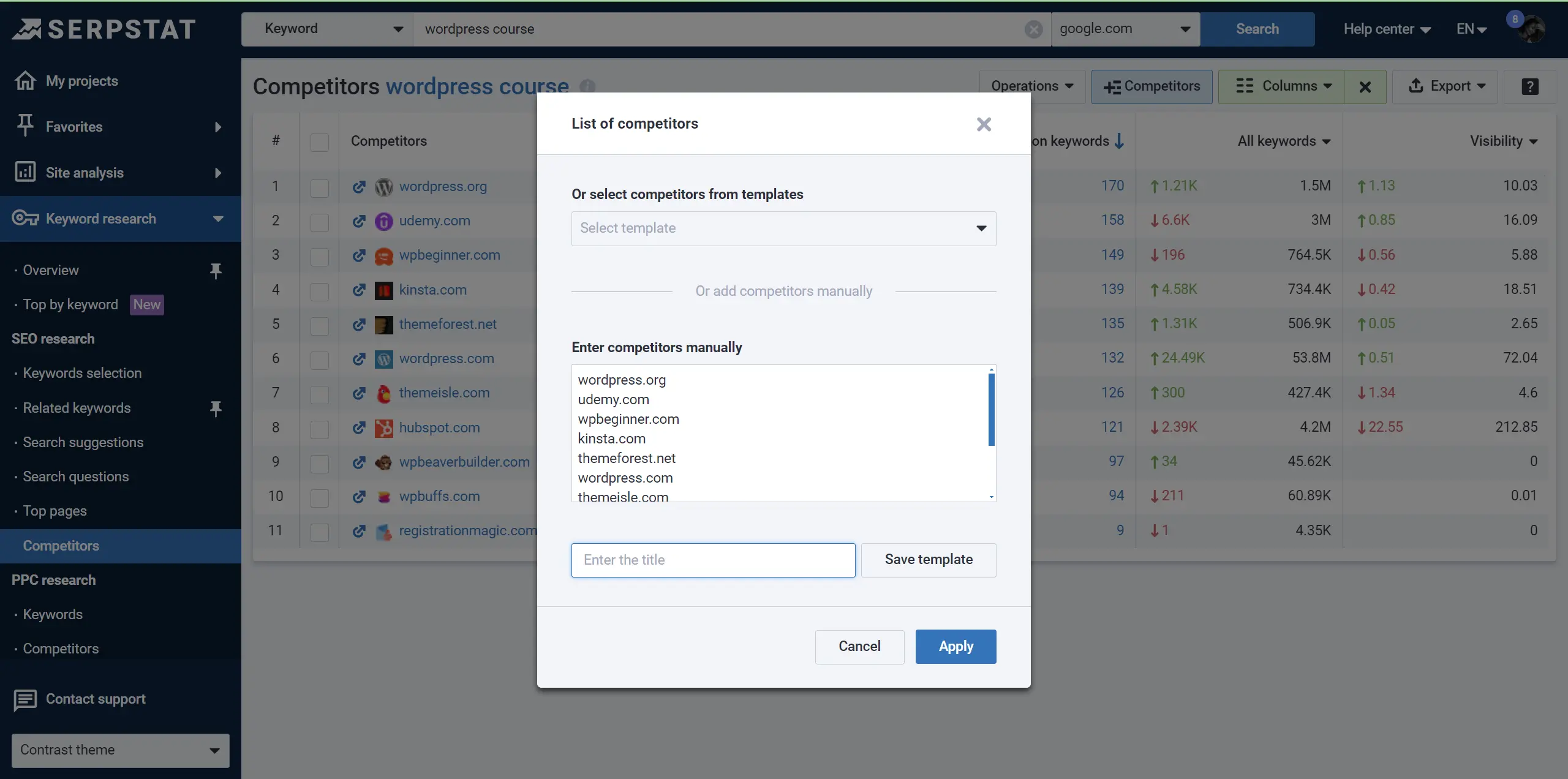
The report is available for both searches: by your domain or by the main keywords.
The competitor list can be exported in CSV, PDF, XLSX format, or to the BigQuery. When using this option, you can either keep all the columns from the table or export only a portion of them.
The same procedure should be repeated for several different search queries. Focus on sites with common keywords and better visibility by checking lists.
The Serpstat API allows faster, large-scale analysis without using the platform interface.

How to Find Competitors of an Existing Site?
Now, let’s analyze the second option, competitor analysis for an established site with a history. In this situation, you can search for competitors by domain.
Professional tools are essential for this task, making it much more manageable than manually. SEO tools generally show competitors in the SERP based on objective data, such as keywords. If the content of your competitors’ websites contains keywords similar to yours in frequency and relevance, they are in close competition with you.
Novice professionals often choose competitors based on keywords alone, without considering the vast difference in volume compared to their site. Let’s say we’re searching for competitors for a small mobile phone store. Amazon and eBay may be listed as competitors, as they may use similar keywords. It may be challenging for a website with limited resources to compete against major e-commerce platforms.
Analyzing and learning from established websites in your industry is crucial for success. Take note of their successful strategies and integrate them into your plan.
Let’s return to the competitor search by domain. Enter the domain address in the search box and select the search database to get data.
The Summary report provides an overview of general information and a detailed list of competitors. For each of the domains, you will see the main statistics:
- SEO traffic;
- visibility;
- organic keywords and their dynamics;
- top pages ranked by the number of keywords.
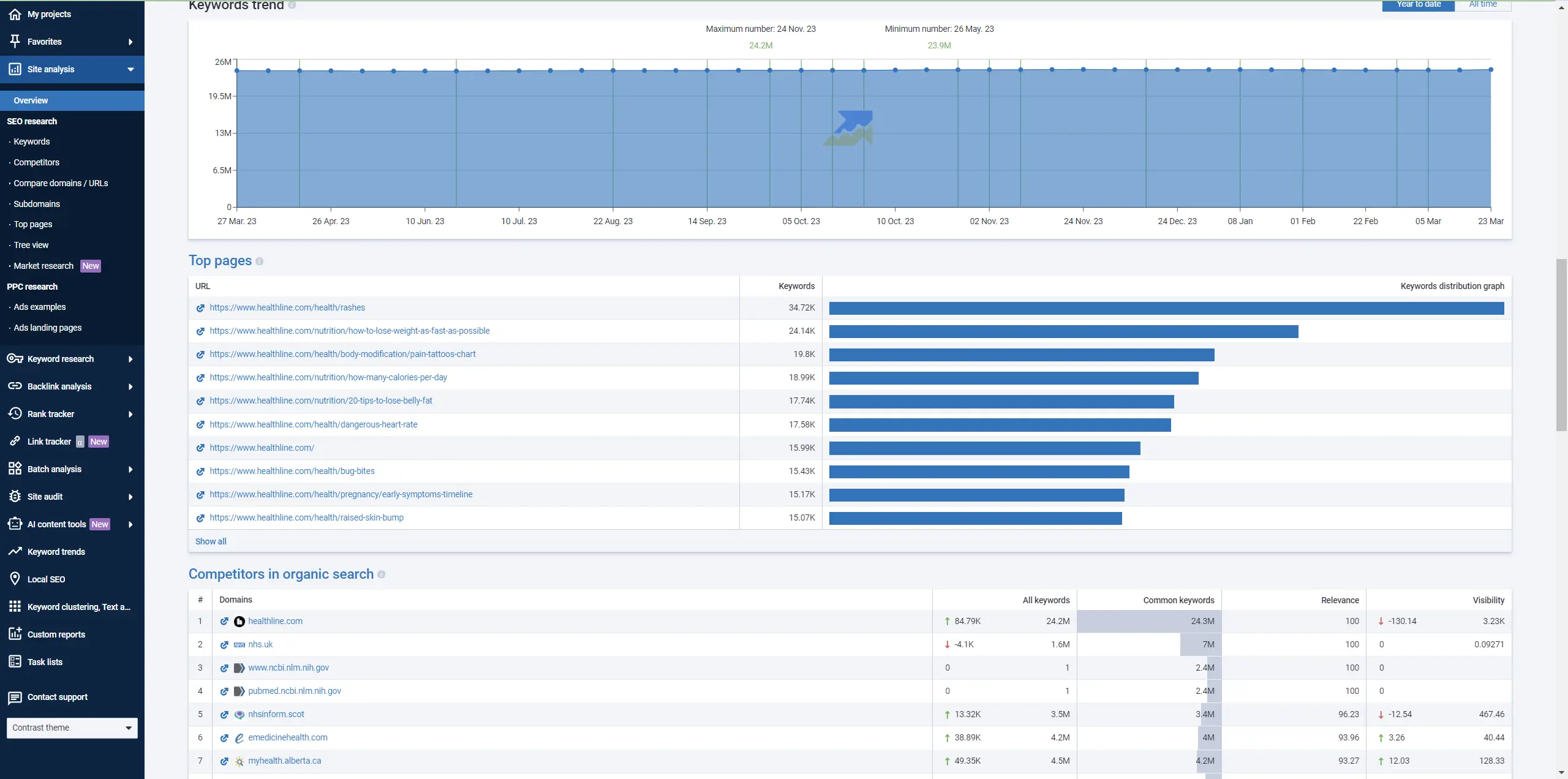
All data can be filtered, uploaded, and visualized in Looker Studio or with custom SEO reports.
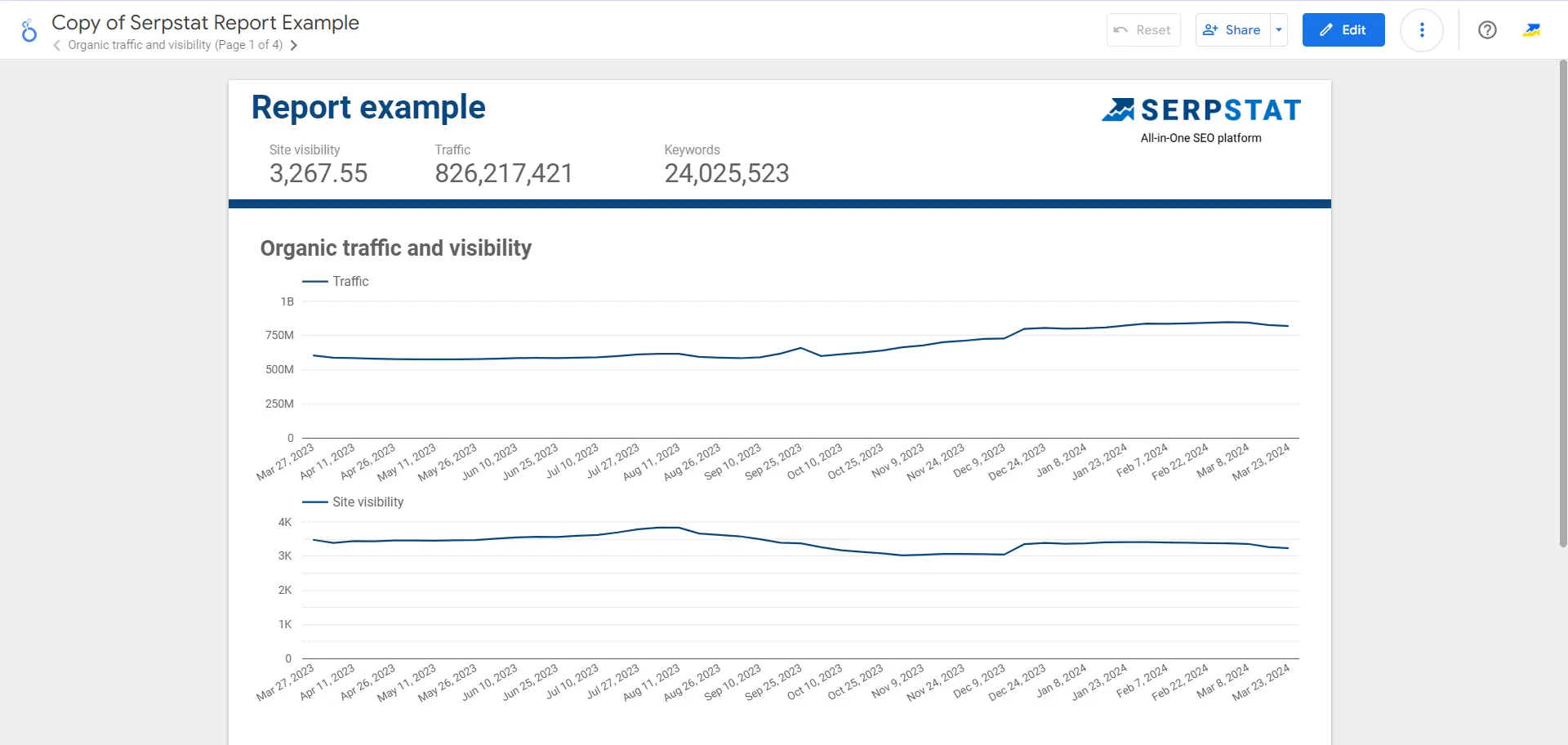
How to Do Competitor Analysis?
The search for relevant competitors is only the beginning of the analysis. The following stages of competitive analysis require using SEO tools and knowledge of digital marketing patterns.
Analyze Competitor Websites
After compiling a list of competitor sites, you should gather general information about each one. This criteria may vary, but it should include the following:
- website address;
- the number of keywords it ranks for;
- information about the marketing tools your competitor uses.
You can gather more detailed information after collecting primary data on competing companies in the SERP. Let’s discuss the essential traits of the businesses further.
Website Quality
Competitive analysis on websites should help answer the question: Why would visitors want to order from this site? Key business characteristics you should focus on for analysis are:
1.The list of available products and services with prices.
2.Features the business offers: service features, discounts, promotional codes, loyalty programs, etc.
3.Reputation indicators: reviews posted on its website and external review sites. This will show the advantages and problem areas of each business’s potential customers. Analysis of the company’s recognition and attracting brand traffic can help identify weaknesses compared to competitors and generate new ideas.
4.The tools competitors use to quickly respond to visitors (online chat or AI chatbots).
In the initial years of a website’s existence, trustworthiness is established. The certain factors it’s based on include:
- the age of the website,
- the history of the domain,
- the level of optimization and promotion activity,
- the quantity, diversity, and quality of backlinks,
- the relevance, quality, and quantity of content.
It is essential to consider the non-obvious yet essential factors when evaluating competitors. One of them is website age.
An opinion states that newer websites are less likely to appear at the top of the search engine results page. There is talk in the SEO community about a search filter called the Google Sandbox, although search engine representatives do not confirm this.
The domain age can be determined using ICANN Lookup. Enter the domain address and click Lookup. You will see the registration **** of the analyzed domain in the “Created” row.
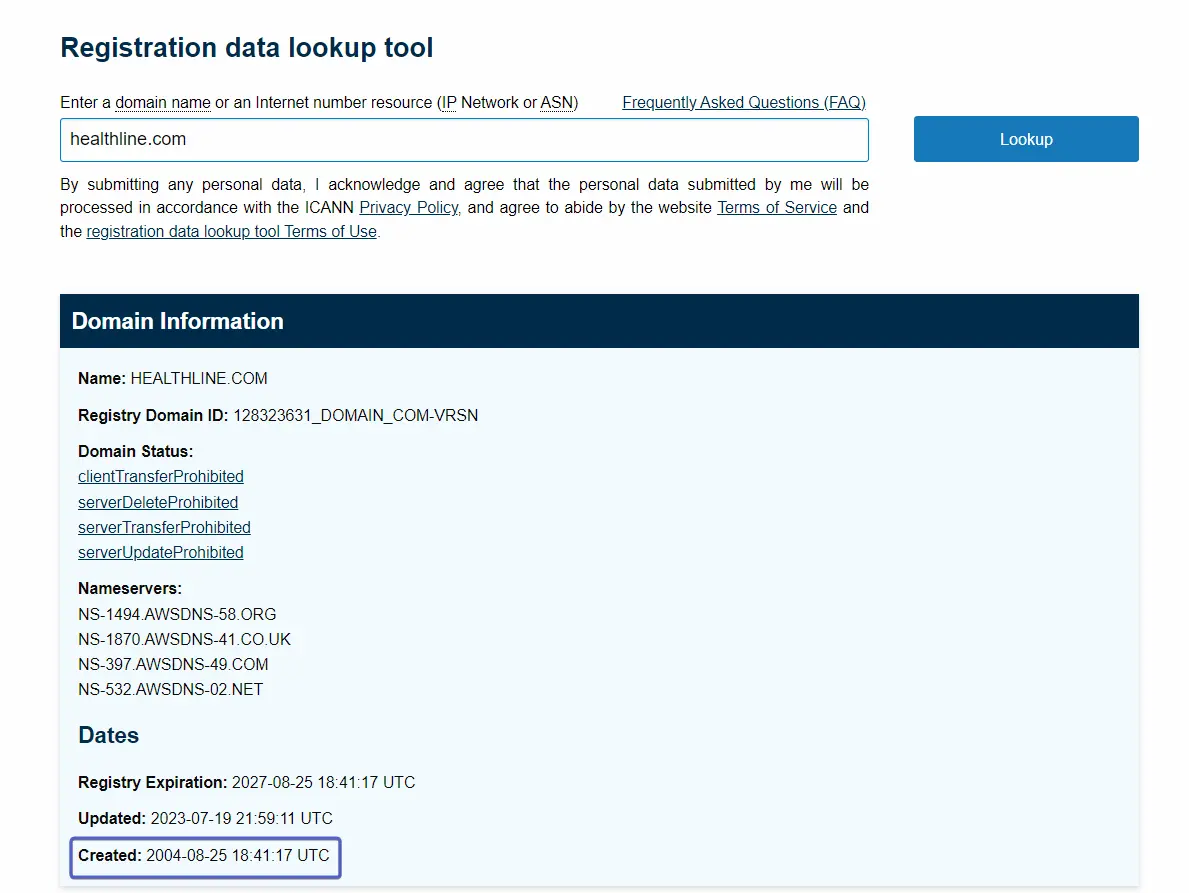
You can easily discover a website’s age by running the Serpstat SEO Checker plugin on the website page.

You can use Serpstat to check a website’s backlink trust. Enter the domain address, go to the Backlink Analysis section, and click Overview.

The report displays the SDR (Serpstat domain rank) indicator. This internal metric shows the site’s level of trust based on the quality of the backlinks. When creating a report on competitors, include this metric for each website. The higher the metric, the more difficult it is to outrank the competitor in search results.
Technical Parameters of the Site
Some other valuable technical factors include:
- Site appearance, page layout design
The visual aspect of a website is the first thing a visitor evaluates. By what criteria should you assess the appearance of competitors’ sites?
1.Design quality. The website requires high-quality images, good font readability, and contrasting buttons with calls to action (CTA).
2.Responsiveness. The website must be compatible with all devices and web browsers, ensuring that it is displayed accurately.
3.Site stability. Design elements should display correctly when viewed. This may affect the user experience and the Core Web Vitals score. If other sites have similar issues, mention them in your report.
4.Usability. A UX specialist should do an in-depth usability audit, but you can do basic usability testing to identify any apparent issues.
5.Site navigation. When analyzing, pay attention to how the site’s structure is arranged. Knowing where the menus are located and whether a search option exists on the site is essential. Take a look at the directory’s pages and categories to develop a more effective site navigation.
If there are a lot of competitors, it is unnecessary to do a detailed technical audit of each one. Instead, it is enough to check the page’s loading speed, surf through the site a little, and observe the structure.
Analyzing the number of pages indexed by Google can help determine the website’s structure and identify indexing errors. It can also explain why only some of the site’s pages are indexed due to deep nesting or an illogical structure.

Here’s an easy way to quickly check the indexing: use the Google search operator “site:” and enter the domain address after without a space:
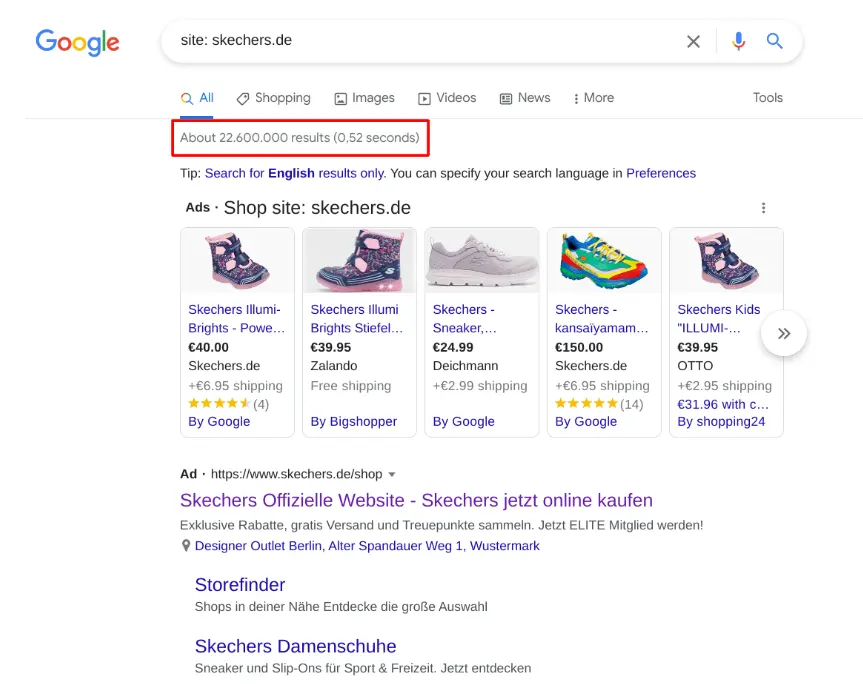
If the site has few competitors, do a technical audit of as many of them as possible and pay special attention to its overall health indicator (SDO — Serpstat Domain Optimization rank).
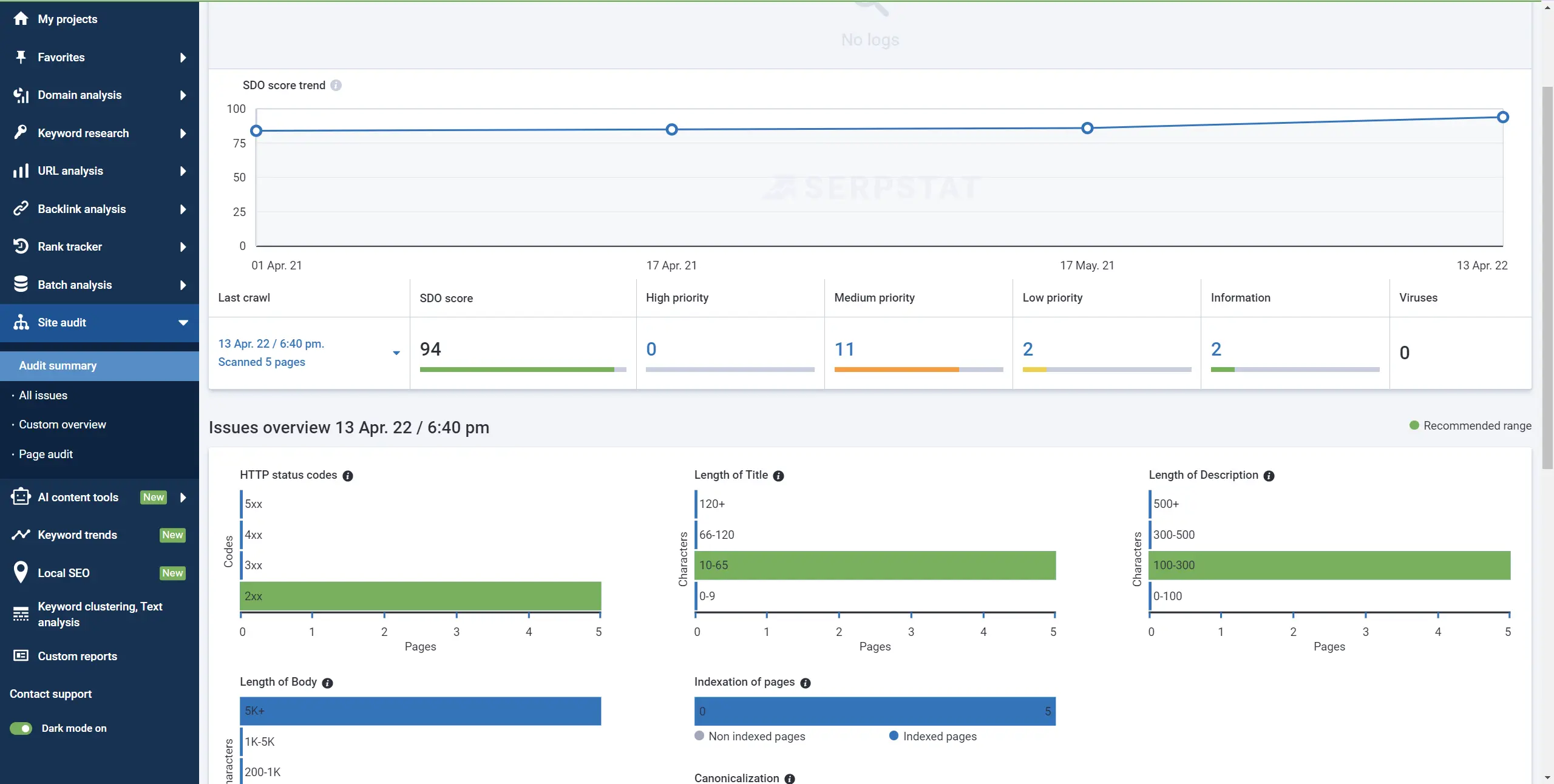
The goal is to ensure your website has a higher SDO than its competitors.
Website Traffic and its Sources
Let’s move on to the next step in the competitor analysis. Estimating the amount of traffic to determine the desired KPIs and properly building an SEO strategy is important. This research will help you to:
- identify strengths and weaknesses
- evaluate the conversion
- select sites for guest publications if needed
- select benchmarks for content and usability.
You can use Serpstat to estimate traffic from organic search results. To collect data, enter a competitor site’s address, choose a regional search base, and click “Search.”

There is a correlation between estimated SEO traffic and actual traffic. Serpstat calculates this value based on the number of keywords in the top 20, the domain’s ranking on the search results page, the volume of queries, and CTR (click-through rate). Comparing your website’s organic traffic with competitors in Serpstat helps you understand the difficulty level in promoting your domain.
The accurate number of visitors in Google Analytics may only be available to the site owner or marketing team members. GA4 (Google Analytics 4) is a free tool. By installing its small snippet of code for analysis on your site, you can:
- Track which pages are most viewed
- Determine where visitors come from (organic search, social media, advertising, e-mail newsletters, or other sources)
- Analyze the behavior of visitors on the site.
A specialized SEO service, SimilarWeb, will help you check traffic sources for competitor sites. So, you will see what role advertising and promotion on social media play for them.

Site Visibility
The visibility indicator displays how prominently websites are presented for search queries. The optimal level of site visibility varies depending on the market segment the site falls into.
Serpstat can evaluate the visibility of sites in the top 20 search results. To check the visibility metric, use the Domain Analysis report. It is displayed next to the estimated traffic indicators. The “Competitors” report also displays the visibility of each site.
The Summary report displays the visibility dynamics of the site throughout the year and its entire presence in the Serpstat search database.

Changes in visibility will show how effective the website promotion strategy is, meaning the higher the visibility, the more influential the strategy is.
We recommend testing Serpstat at this stage of training to put all the knowledge you have got into practice!
For all the important insights outlined in this article, watch the video on competitor analysis:
Competitor SEO Keywords
A critical analysis component is the study of the competitor’s keyword list. By understanding what queries other companies in your industry use, you can adapt your strategy to outrank them.
The keywords list refers to the keywords related to the website’s primary focus or subject matter. This compilation serves as the foundation for developing the structure and substance of each website page.
Keywords competitor analysis is vital for several reasons:
- It helps to evaluate the effectiveness of competitors’ SEO strategies
- You can supplement and improve the keyword list for the promoted site
- You have the ability to select which search queries will give you an advantage over your competitors and increase your keyword list.
Use the “Domain Analysis” tool, “Keywords” tab to do keyword research with Serpstat. Enter the competitor’s domain and specify the search region.
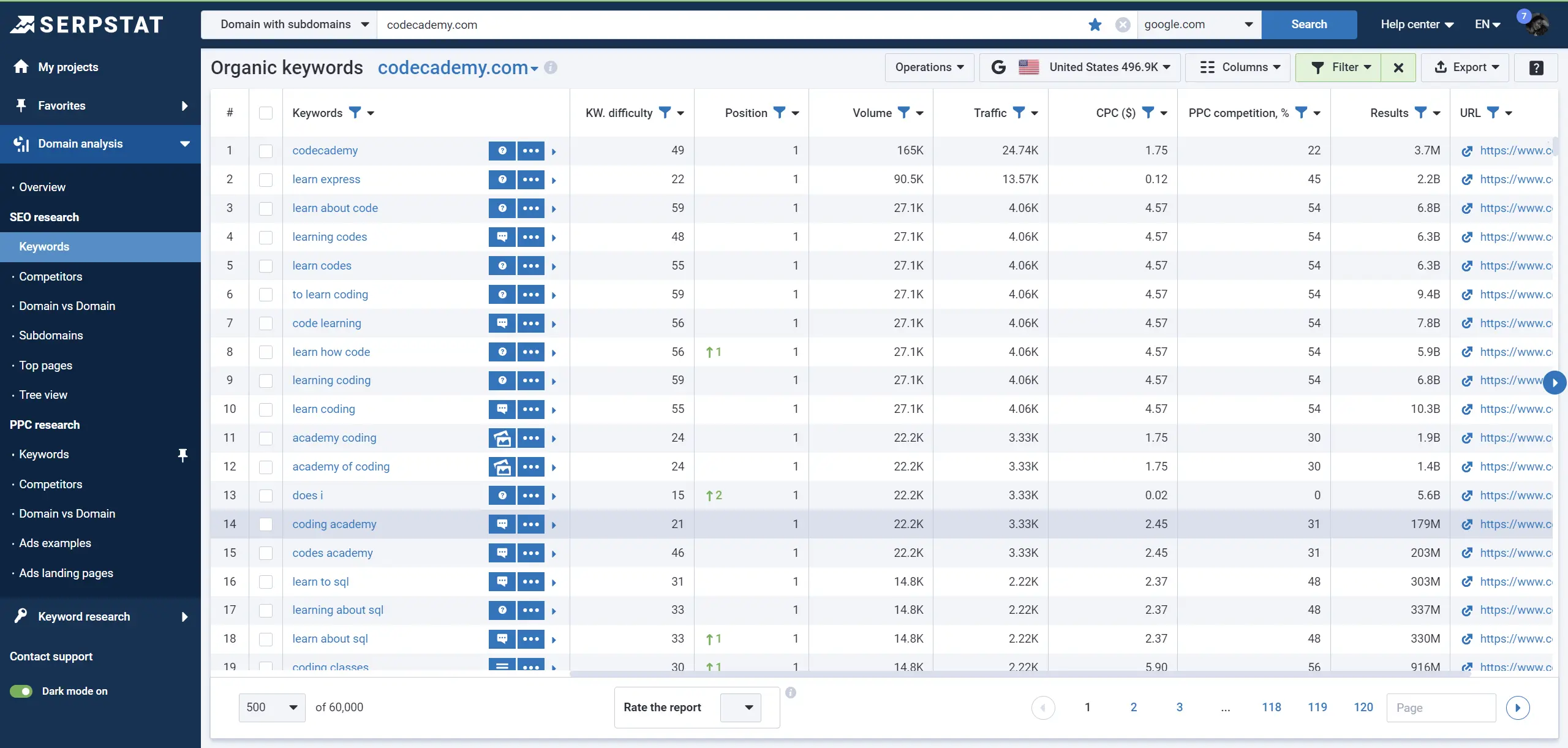
The columns with the query, search volume, difficulty for organic promotion, and the target URL are the most important.
It is important to understand how search queries are distributed by ranking and how the number of keywords affects the display of a website. This information is needed to evaluate a competitor’s SEO strategy. You can access the domain analysis Summary report to view the data.

Suppose the number of search queries is growing or remains stable. In that case, the promotion strategy is effective, and you should look closely at a competitor to incorporate their best practices.
Site Structure
The structure of a website should be logically organized to provide a user-friendly interface that enhances user experience.
When evaluating the keyword list of competitors, it is crucial to see how keywords are distributed across the site’s pages. To do this, use the Tree View report.
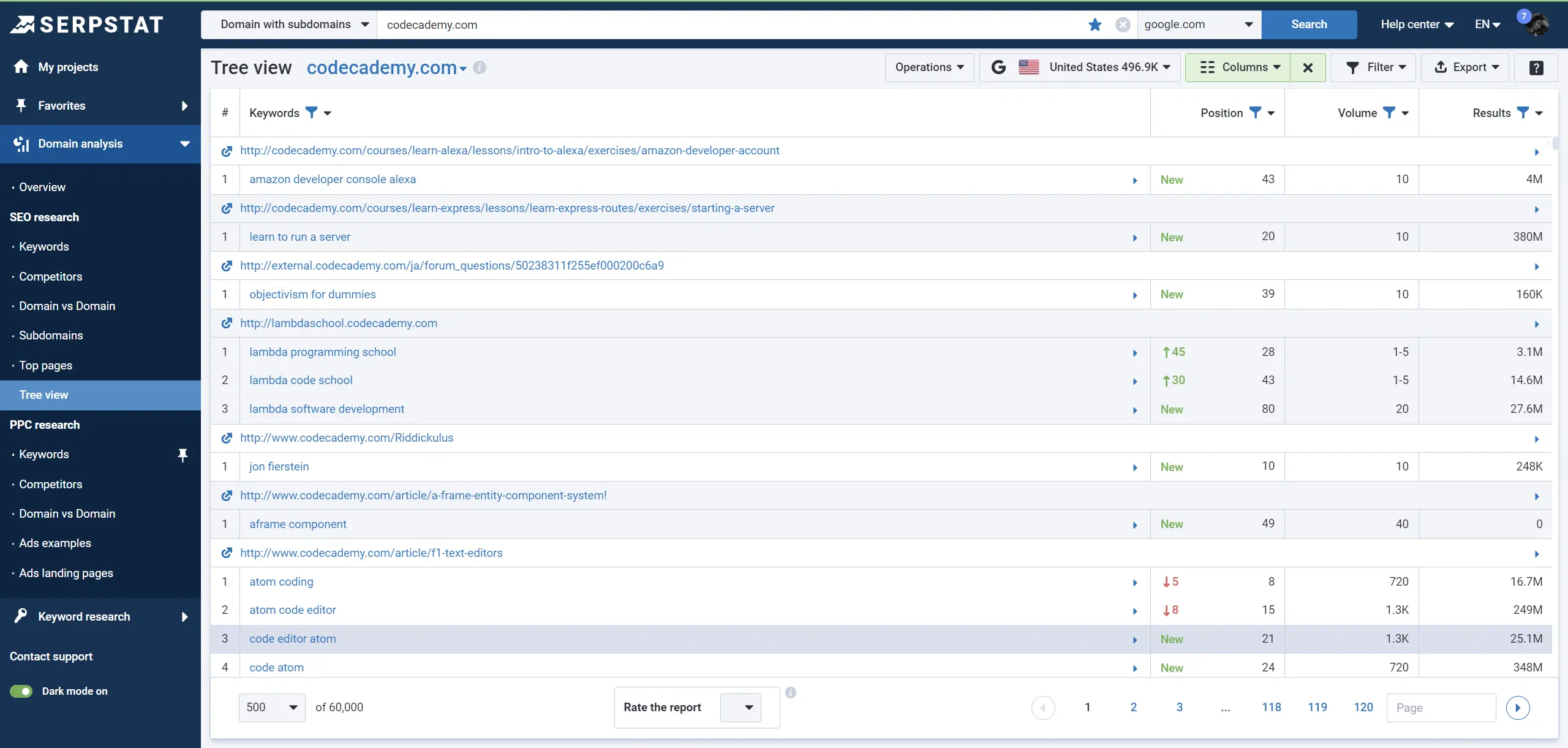
Find out which search queries display a webpage within the top 100 Google results.
Top Competitor Pages and Content on Them
After studying a competitor’s keyword list and structure, you must identify which pages drive the most traffic. You will find many practical solutions for optimizing your site’s content by doing this.
In the “Site Analysis” section, find the “Top Pages” tab.

You can analyze a few of the top pages of each site. Take note of brief answers to the following questions for each page:
It could be a particular blog post, the home page, or a landing page — a separate page designed for marketing or advertising purposes that aims to increase conversions.
For example, filters, product comparison functionality, calculators, videos, and reviews.
It could be images, infographics, tables, or checklists.
This information will be needed for the content brief to the copywriter. Pay attention to how the subheadings on the page are composed.
In the overall evaluation of the text and its quality, you will need to develop your approach.
Metadata on Pages
Site metadata or meta tags are elements of HTML code (HyperText Markup Language) that search engines analyze to recognize the page’s content correctly. Meta tags are HTML elements that provide metadata about a webpage and are used by search engines to understand its content. They are located inside the <head> element and defined using the <meta> tag. Meta tags are not visible to users on the webpage.
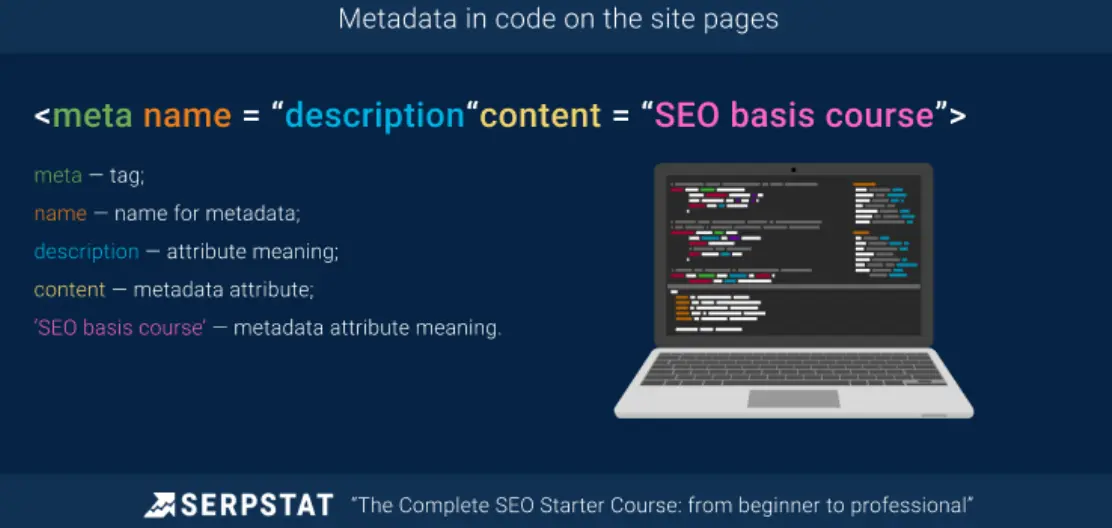
They must be used on each page according to the requirements of the search engine. The list of meta tags defined by Google consists of <meta name=”description”, <meta name=”robots”, <meta name=”googlebot,” etc.
Analyzing the high-traffic pages of competitors, look at how their H1 and Description are built. Website ranking and CTR in search results heavily depend on metadata.
The Title tag is an HTML element that defines the page’s title and briefly describes the content. It plays a crucial role in optimization since, together with the description, it often creates a page snippet in search results.

What should you look for when analyzing meta tags?
1.Review the page tags to identify the keywords used and how they were employed.
2.Check numbers, special symbols, exclamation, and question marks, which can increase CTR.
3.Pay attention to the HTML elements’ size and structure for each competitor’s top pages.
SEO Competitor Backlinks and Anchors
The term backlink volume refers to the total number of links from other websites that are being analyzed. Gathering information about a site’s backlink profile during the competitor analysis phase is crucial.
It is essential to understand:
- How many backlinks does a site need to rank at the top of Google?
- What links provide the maximum effect for promotion?
- How fast should you build backlinks?
- What indicators are essential when analyzing the backlink volume?
For each of the competitors, you need to collect the following information:
- the total number of backlinks;
- the number of referring domains;
- ratio of do-follow and no-follow links;
- number of external links;
- domain trust index.
You can get detailed information about competitor backlinks in “Backlink Analysis” — “Overview.”
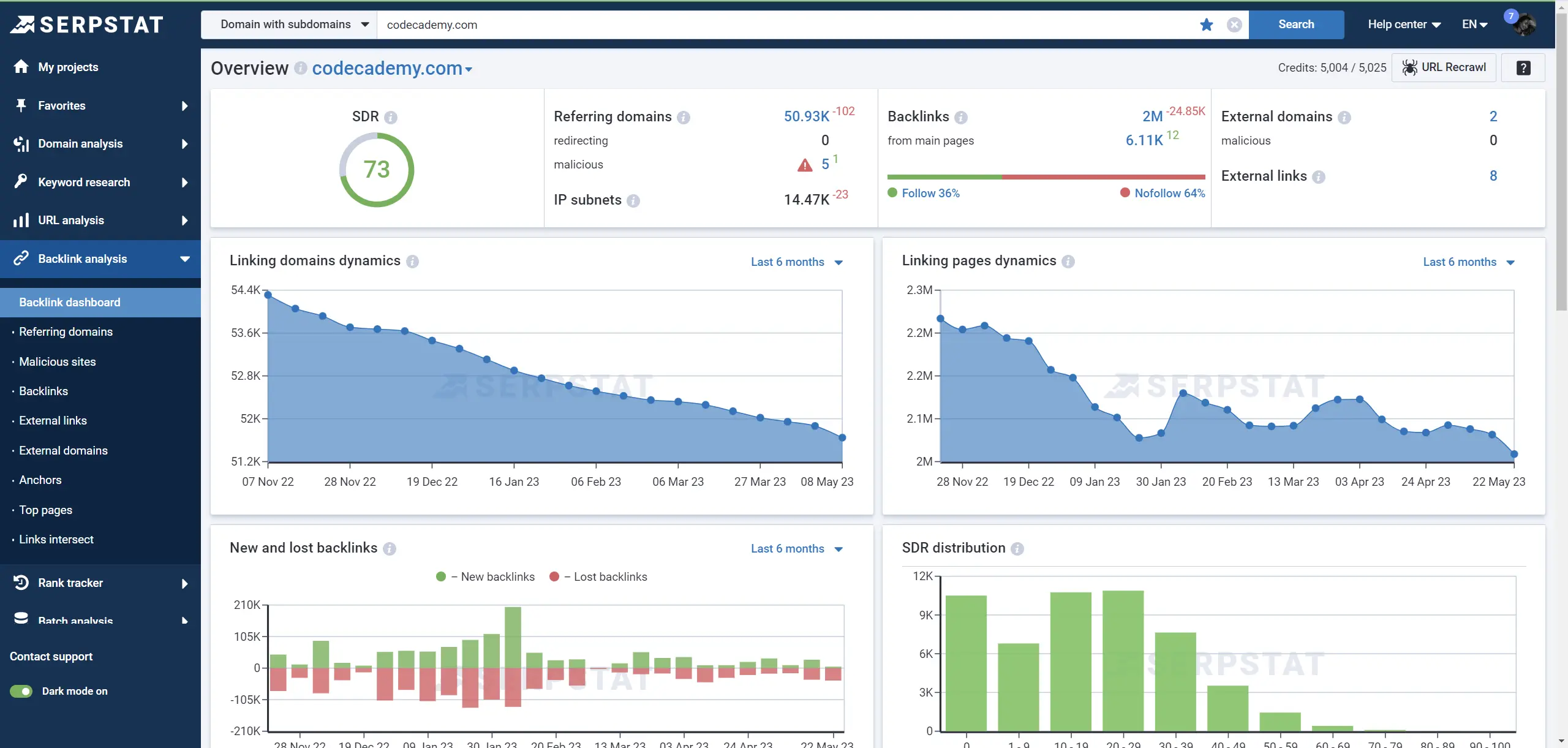
These indicators will help you understand how backlinks promote a particular site and how actively your competitor builds up backlinks.
When a user clicks on a link, the anchor text directs them to the destination page.
<a href=”www.example.com”> This is an anchor </a>
However, some links may not have an anchor; instead, they may use generic text like the URL or words such as “here” or “more.” In the world of SEO blogs, there is conflicting advice regarding anchor text versus non-anchor links.
There are three main guidelines to follow:
1.The anchor list should not be dominated by anchors with the commercial words “buy,” “price,” etc.
2.The anchor list should be as diverse as possible.
3.Most of the backlink volume should consist of non-anchor links.
To find the correct anchor ratios, use the Anchors Serpstat report. For each anchor, you will see the number of domains and links, including nofollow attributes where applicable.
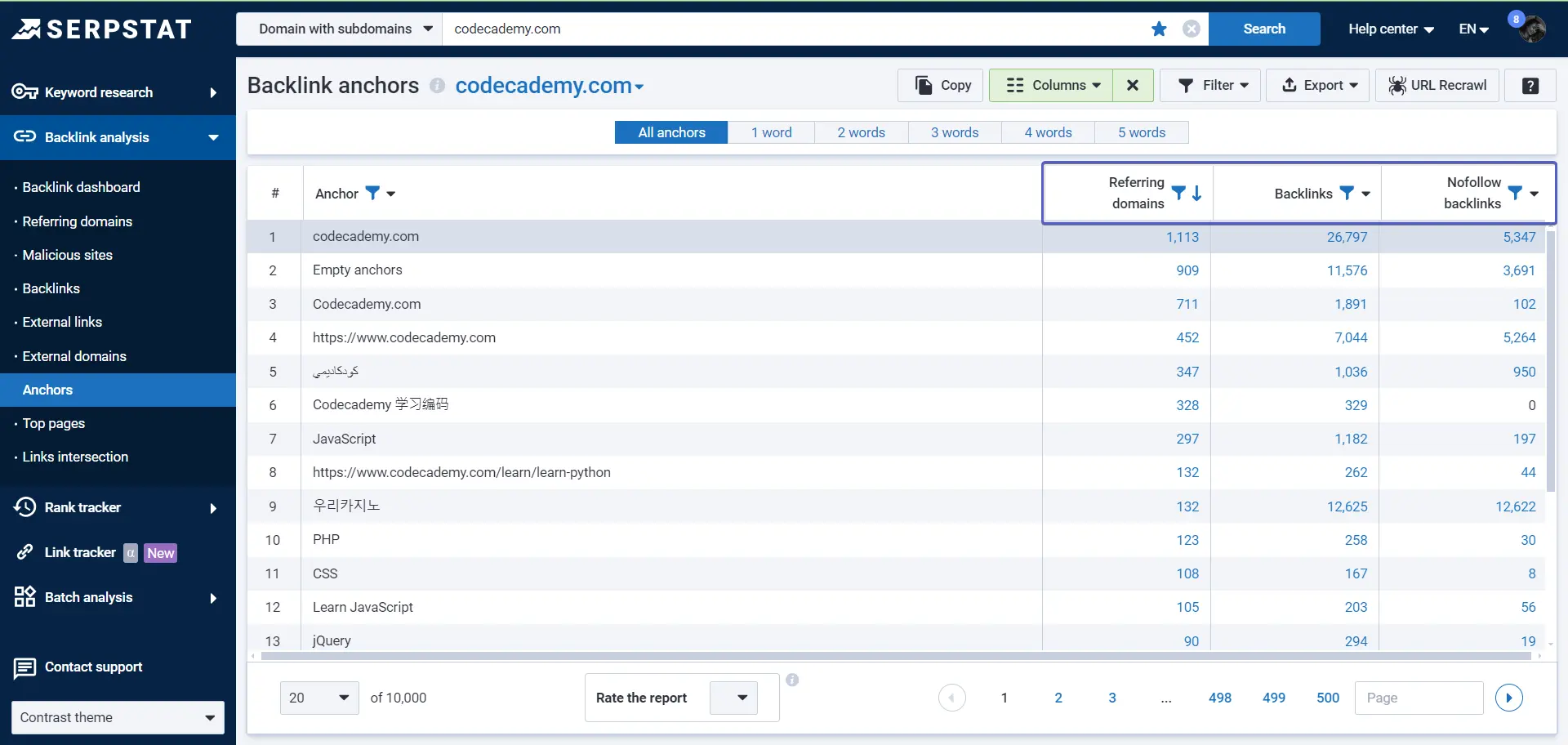
If a website has a lot of competitors, the analysis process might take a long time and require significant resources. In such a situation, you can use Serpstat’s Batch analysis of domains. This feature allows you to select the necessary metrics for each project and obtain information on up to five Google search databases.
Summary
Competitor analysis involves evaluating technical conditions, rankings, website structure, backlink profile, and website trust, among other factors.
It is an essential step in SEO work. Based on the information collected, you will be able to:
- develop an effective SEO strategy;
- choose the most effective techniques and promotion tools;
- designate optimal KPIs for promotion;
- create a work plan to improve the promoted site;
- understand what tools to use for promotions.
Wish you a lot of valuable, meaningful, and practical insights ahead!
